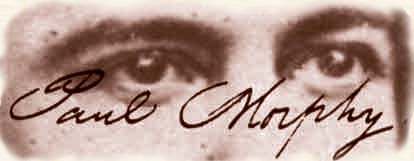|

 Paul Morphy: The Endgame
Paul Morphy: The Endgame
" On July 10, 1884, on an unusually hot and oppressive day,
after his return from his daily promenade on Canal street, without waiting
to cool off from the effort of exercise, he immediately indulged in a cold
bath."
- Regina Morphy-Voitier,
Life of Paul Morphy in the Vieux Carré of New-Orleans and Abroad
His mother grew alarmed when he stayed over an hour taking his bath.
Since he didn't respond to her and since the door was locked, she called
on a neighbor, Monsieur Mollo to force his way inside. They called a
doctor who pronounced Paul Morphy dead from "congestion of the brain."
"On the table, not far from the bed, lies the family chess-board upon
which many chess-men stand: a contest never to be decided. The bureau is
strewn with the books read last; there are some references and notes on
the margins, one incomplete, never to be ended. The whole atmosphere is
impregnated with his spirit's ultimate exhalation. And the dolorous
symphony of sobs and groans fills the air, rousing the echoes of the vast
and empty rooms."
First and Last Days
of Paul Morphy - Léona
Queyrouze
His funeral was held the next day - July 11, 1884. Charles A. de
Maurian, his brother Edward and his cousins Edgar Oliver Hincks,
E. A. Morphy, Leonce J. Percy, Henry F. Percy served as pall
bearers. Paul was buried in the family crypt in the St. Louis
cemetery.
|

Morphy's Obituary New Orleans Times-Democrat - July 10, 1884
(a fragment reproduced from of The Chess
Player's Chronicle, August 20, 1884)
Reminiscences of Morphy
by Charles A. Maurian
His actual retirement from all serious play may be said to date
from 1860 at least- many long years before the melancholy mental
affliction that clouded and darkened his later days fell upon him.
And it is but just to the noble game whose history and whose lore
he so enriched and adorned during his brief career as a player, to
say here that it was in no wise responsible for the disaster that
befell its afflicted monarch. Sorrows, misfortunes and trials of
other character, and such as might have destroyed the balance in a
far less delicate organization than his, were the potent agents
that wrought the ruin of which Caïssa is so generally and so
unjustly accused. The frailty of his physique was evident at a
glance and the very manner of his death demonstrated it more
clearly. A cold bath on a summer's day brought on a congestion of
the brain that proved almost immediately fatal.
And here, before we close, speaking as knowing whereof we speak,
we deem it best to correct two generally received impressions as
to the departed master. First, then, Paul Morphy was never so
passionately fond, so inordinately devoted to Chess as is
generally believed. An intimate acquaintance and long observation
enable us to state this positively. His only devotion to the game,
if it may be so termed, lay in his ambition to meet and to defeat
the best players and great masters of this country and of Europe.
He felt his enormous strength, and never, for a moment, doubted
the outcome.
Indeed, before his first departure for Europe he privately and
modestly, yet with perfect confidence, predicted to us his certain
success, and when he returned he expressed the conviction that he
had played poorly, rashly ; that none of his opponents should have
done so well as they did against him. But, this one ambition
satisfied, he appeared to have lost nearly all interest in the
game. He kept in some degree, the run of its general news, even up
to the date of Mr. Steinitz's visit to this city last year, but he
could rarely be induced to discuss chess, and nothing more annoyed
him, even years ago, than to be designated as "Morphy, the chess
player."
In the second place, Morphy was a thoroughly educated and
cultivated man, and there is not the shadow of a doubt that but
for the misfortunes of his times, and the melancholy affliction of
his later years, he would have been capable of great results in
lofty spheres of human action. There is no graver error than to
suppose he was capable of nothing but playing chess. He was,
moreover, in every sense, a gentleman of high delicacy, culture
and refinement, both innate and acquired; and even clouded as his
mind was in the latter years of his life, these qualities were
marked. There was much of the true Hidalgo about him.
|
|

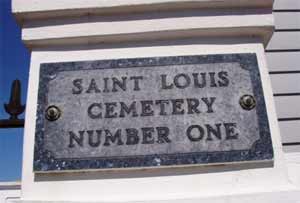
Born out of great sorrow and necessity, St.
Louis Cemetery No. 1 is the oldest remaining
cemetery in New Orleans.
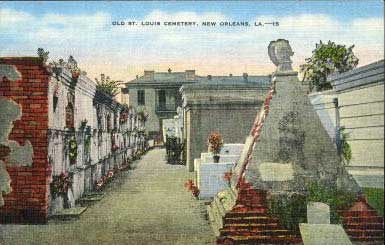
Most of the tombs are
the single-family crypts preferred by the Creoles. The casket is
placed in the crypt. and after a given time the family
removes a casket, burns it and places the remains in a crypt
beneath the chambers. This way the tomb can serve for generations.
A slab of marble covering the opening lists the names of the
departed. Often the first names are worn away by time. |
|
Morphy's tomb amid the general disrepair of St. Louis Cemetery
#1
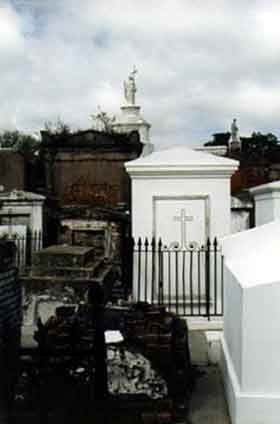
A closer look at Morphy's tomb
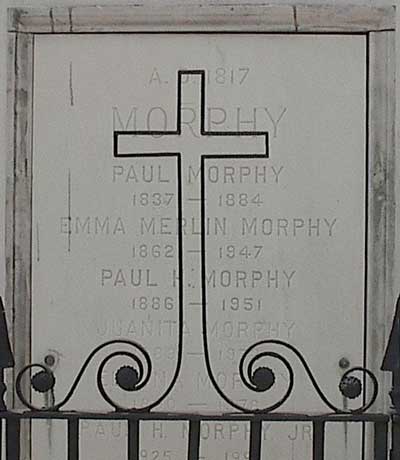
Paul Morphy was interred at #366 - shown in the map below.
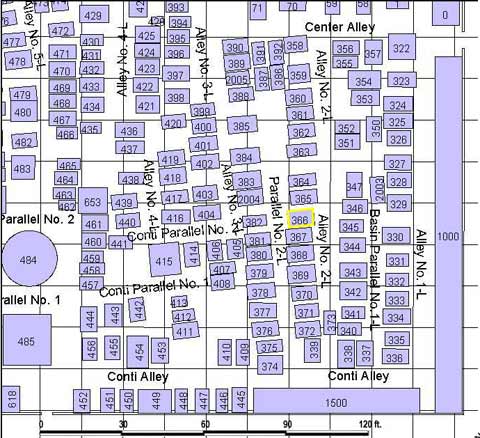
A photograph of St. Louis Cemetery #1 around 1910
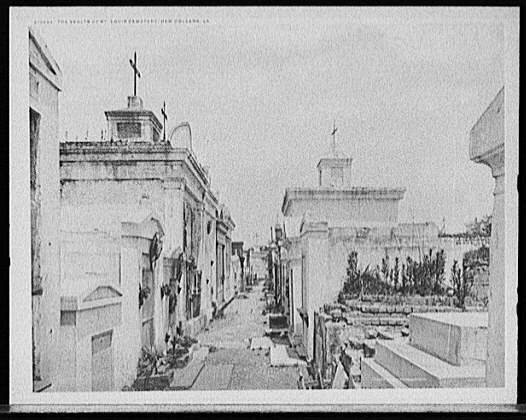
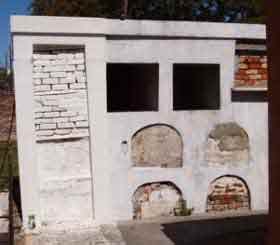
an inside view of the "oven" feature of a typical tomb.
|
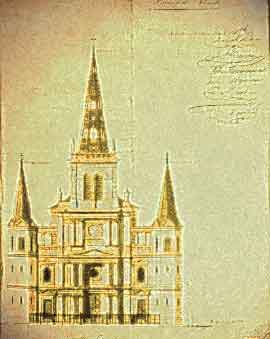
Paul Morphy's funeral was held in the Saint Louis Cathedral..
The Saint Louis Cathedral is the oldest church in Louisiana as well
as one of the oldest in the United States. The original building
was destroyed in 1722 by a hurricane. It was rebuilt in 1727 and
subsequently destroyed by a fire in 1788. The building that exists
today was erected in 1794 though without many of the details that
make it so unique. The center spire was added and between 1845-51,
the wings with the smaller spires were built.
The Saint Louis Cathedral was dedicated to King Louis IX of France.
The architect-engineer, Adrien De Pauger, who designed the 1727
version, died in 1726. He asked to be buried within the
yet-unfinished structure. The rebuilding of this French
cathedral after the Good Friday Fire of 1788 was, oddly
enough, financed by Don Andres Almonester y Roxas, a wealthy
Spaniard originally from Andalusia.
While the old church burned on Good Friday, 1788, the new
cathedral re-opened on Christmas Eve, 1794. As the Vieux Carré
was notable for its caste system, the St. Louis Cathedral was
remarkable for its openness to all Catholics regardless of race or
social status. It saw the baptisms, weddings and funerals of
the greatest leaders and the lowliest slaves.
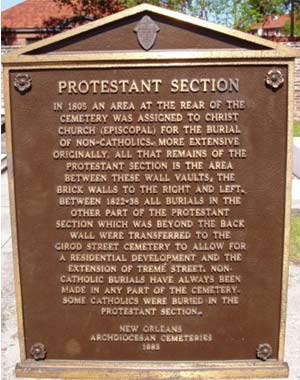 The
first independent cemetery in Vieux Carré was located in the St.
Louis churchyard on the west side of St. Peter Street between
Burgundy and Rampart Streets. This was called the St. Peter's
Cemetery. Only the wealthy and prominent could be buried at St.
Peter's but, even so, with its below ground burials, it soon
filled to capacity. St. Louis Cemetery #1 was built to replace St.
Peter's. This was in 1788 after the Good Friday Fire. This
fire, which burned down the church, also destroyed 80% of the
city. A few months later, New Orleans was ravaged by a hurricane.
In the midst of such destruction, an epidemic broke out. In an
effort to separate the burial grounds from the population, St.
Louis #1 was built outside of Vieux Carré proper. Unlike St.
Peter's, the new cemetery was open to all, even Protestants. It is
owned and maintained by the Archdiocese of New Orleans. The
first independent cemetery in Vieux Carré was located in the St.
Louis churchyard on the west side of St. Peter Street between
Burgundy and Rampart Streets. This was called the St. Peter's
Cemetery. Only the wealthy and prominent could be buried at St.
Peter's but, even so, with its below ground burials, it soon
filled to capacity. St. Louis Cemetery #1 was built to replace St.
Peter's. This was in 1788 after the Good Friday Fire. This
fire, which burned down the church, also destroyed 80% of the
city. A few months later, New Orleans was ravaged by a hurricane.
In the midst of such destruction, an epidemic broke out. In an
effort to separate the burial grounds from the population, St.
Louis #1 was built outside of Vieux Carré proper. Unlike St.
Peter's, the new cemetery was open to all, even Protestants. It is
owned and maintained by the Archdiocese of New Orleans.
New
Orleans has always been prone to epidemics such as yellow fever
and cholera. Over the years many remedies had been tried. In 1821
the recently formed Board of Health ensured the passage of an
ordinance forbidding the open viewing of a body and banning
funeral processions through the streets during the time between
from the first day of July through December. In order to
circumvent the funeral procession from the church to the cemetery,
a chapel was erected at the cemetery itself. It was called the
Mortuary Chapel of St. Anthony. It still stands today under the
name, Our Lady of Guadalupe Church. |
|
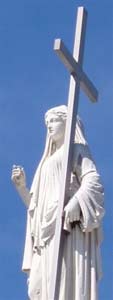 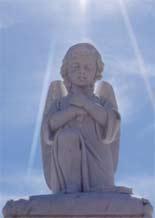 There are more than 30 above-ground cemeteries in New Orleans.
Most are in various states of disrepair. The St. Louis Cemetery #1
became listed on National Register of Historic Places in 1975 and
in 2004 funds became available for a major restoration. It's only
fitting. The Creole writer, Grace King, referring to the St. Louis
Cemetery #1 in 1895, wrote it "is the mother cemetery ... the
Vieux Carré of the dead; as confused and closely packed a
quarter as the living metropolis...
There are more than 30 above-ground cemeteries in New Orleans.
Most are in various states of disrepair. The St. Louis Cemetery #1
became listed on National Register of Historic Places in 1975 and
in 2004 funds became available for a major restoration. It's only
fitting. The Creole writer, Grace King, referring to the St. Louis
Cemetery #1 in 1895, wrote it "is the mother cemetery ... the
Vieux Carré of the dead; as confused and closely packed a
quarter as the living metropolis...
|
|
